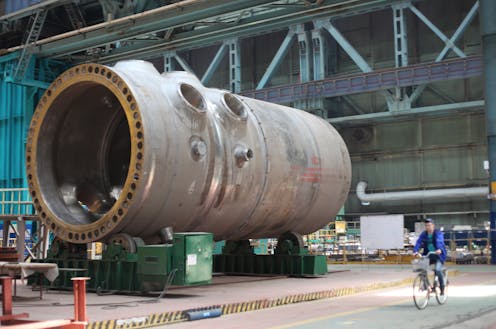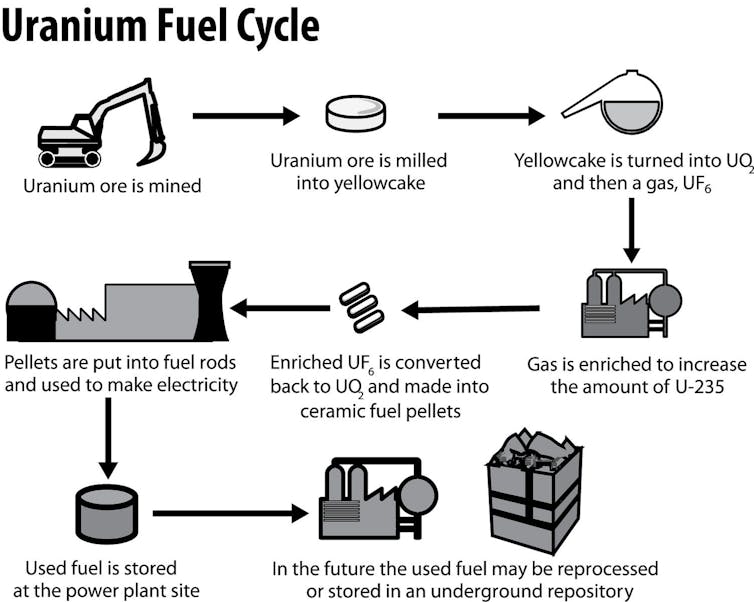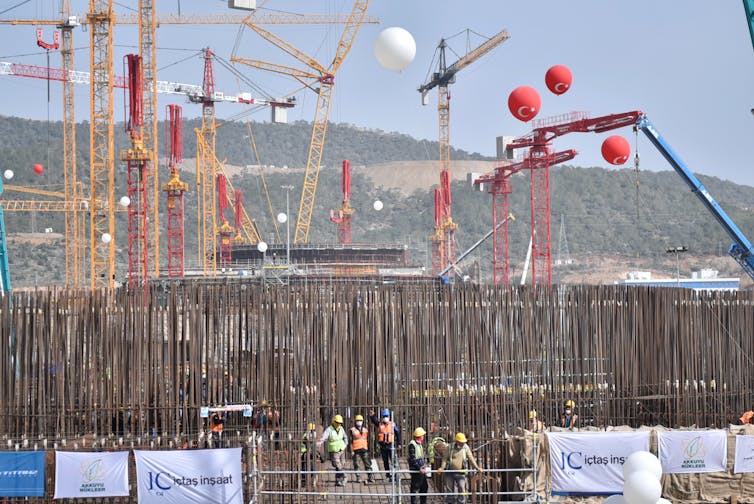Russia's energy clout doesn't just come from oil and gas – it's also a key nuclear supplier
Russia isn’t a major producer of uranium, but it handles a large share of the steps that turn it into nuclear fuel. That makes it a major player in this globalized industry.

As Western nations look for ways to reduce their reliance on Russian oil and gas, another aspect of the Ukraine crisis has received less attention: Most of the 32 countries that use nuclear power rely on Russia for some part of their nuclear fuel supply chain.
Nuclear power is a critical part of many national electricity grids. European countries especially rely on nuclear power, including France, where it produces 69% of the nation’s electricity supply, Ukraine (51%), Hungary (46%), Finland (34%) and Sweden (31%). In the U.S., nuclear reactors generate 20% of the nation’s power. Many of these countries originally embraced nuclear power to minimize dependence on imported fossil fuels and, more recently, to reduce carbon emissions and improve air quality.
Economic fallout from the war in Ukraine could disrupt access to fuel for the nuclear power industry. We believe that countering Russia’s influence will require concerted efforts that balance energy security, climate mitigation and a commitment to international law.
A global industry
Around the world, 32 countries operate about 440 commercial nuclear power reactors that generate 10% of the world’s electricity supply. The U.S. has the most operating reactors (93), followed by France (56) and China (53).
Many nations export nuclear fuel, materials and services. The leading international suppliers are the U.S., Russia, Europe and China. Several other countries play important roles, including Canada and South Korea.
Producing nuclear fuel involves five steps:
– Raw uranium ore, which usually contains less then 2% uranium, is mined from the ground.
– The ore is milled to separate the uranium from other materials, yielding a powder called yellowcake.
– Yellowcake is chemically converted to gaseous uranium hexafluoride.
– Uranium hexafluoride is processed to increase its concentration of uranium-235, which can be split in reactors to produce large quantities of energy. U-235 only makes up 0.7% of natural uranium; enrichment for commercial reactor fuel increases its concentration, usually up to 5%.
– Enriched uranium is fabricated into fuel rods for reactors.

Uranium conversion, enrichment and fabrication are sophisticated technical processes that are handled at a small number of facilities around the world.
Fuels for nuclear reactors are highly specialized and tied to specific reactor designs. Buying a power reactor from a supplier such as Rosatom, Russia’s state nuclear company, or the French company Framatome, can lead to decadeslong supply dependencies.
All of these factors make nuclear supply chains more complex, less competitive and harder to shift rapidly than other energy types, such as oil and gas. And since key materials and technologies for civilian nuclear power can also be used to produce weapon-usable nuclear materials, international nuclear sales are subject to strict export controls and trade restrictions.
Russia as a nuclear supplier
Compared to other mined commodities such as cobalt, world uranium resources are spread reasonably widely. Kazakhstan produces more than 40% of the global supply, followed by Canada (12.6%), Australia (12.1%) and Namibia (10%). Russia is a minor player, producing around 5%, while the U.S. and Europe produce less than 1%.
However, much of the milled uranium from Kazakhstan travels through Russia before it is exported to global markets. Other parts of the supply chain also route through Russia. Only a handful of facilities in the world convert milled uranium into uranium hexafluoride; Russia produced approximately one-third of the 2020 supply, much of it made with uranium from Kazakhstan.
Russia also has 43% of the global enrichment capacity, followed by Europe (about 33%), China (16%) and the U.S. (7%). There is some spare capacity in the U.S. and Europe, and China is expanding.

Before it invaded Ukraine, Russia had a national strategy to increase its nuclear energy exports. It is a leading supplier of nuclear reactors, building plants abroad and then providing their fuel. Its customers include former Soviet states and Warsaw Pact members like Ukraine and Hungary, along with new nuclear power users such as Egypt.
Some 16%-20% of the annual U.S. uranium supply is at least partially sourced from Russia, mainly for enrichment. Many European countries buy converted or enriched Russian uranium, and China is a growing market for Russian nuclear exports.
If U.S. nuclear trade with Russia is affected by the Ukraine conflict, the most serious impact would be on two planned advanced reactor demonstration projects: the Xe-100 in Washington state and Natrium in Wyoming. These reactors need fuel that is enriched to nearly 20% uranium-235, and Russia is currently the world’s only supplier.
Market impacts of the Ukraine crisis
Global uranium prices were low for most of the past decade, hovering between $20 to $30 per pound after the Fukushima nuclear disaster in Japan. Then in 2021 and early 2022, market speculation and domestic protests in Kazakhstan pushed prices up. Now, the war in Ukraine has driven some trades to almost $60 per pound, and potentially higher. Uranium is not openly traded on markets, so not all prices are public.
The Biden administration reportedly is considering nuclear sanctions on Russia. U.S. utilities oppose this step for fear that it would make uranium fuel scarcer and more expensive. Many U.S. nuclear plants are already struggling economically.
If Russia retaliates against Western pressure by withholding converted or enriched uranium, we estimate that plants in the U.S. and Europe could be affected within 18 to 24 months, based on the amount of advanced notice required for fuel orders. Some U.S. utilities have said they do not expect shortages, but the opacity of the market and long time frames make this hard to predict. Utilities will face higher prices if they turn to Europe, Japan or China for uranium conversion or enrichment services.
What about uranium supplies? Western producers – notably, Canada and Australia – have large reserves that would be economic to mine at current price levels. And some U.S. politicians, mainly in western states, are calling for more domestic mining.
But this would be controversial. Over 500 abandoned mines remain from extensive uranium production across the Navajo Nation in Arizona, Utah and New Mexico during the Cold War. These areas are still experiencing harmful effects, including environmental contamination and claims of mysterious illnesses and cancers.
Opportunities for U.S. leadership
Rather than focusing on domestic uranium mining, we see it as a higher priority for the U.S. to reconsider its enrichment capabilities and policies. Private companies have been reluctant to invest in new enrichment facilities while cheaper alternatives like importing from Russia were available. The Department of Energy is moving forward on a program to fund fuel production for advanced reactors, but it might have to also focus on making fuel for existing U.S. reactors if Russia’s supply is interrupted.
In our view, the U.S. should also work to counter Russia’s efforts to export fabricated fuel and reactors. Ukraine is already working with U.S.-based Westinghouse to develop fuel for its Russian-designed reactors that can replace Russian-manufactured fuel. Seven of Ukraine’s 15 reactors already use this fuel, which is fabricated in Sweden. We believe U.S. policy should support similar efforts elsewhere as needed.
Finally, if the U.S. and other countries seek to remake world nuclear supply chains, we believe the nuclear industry should strive to transcend its toxic legacy. This would require engaging at the start with affected communities, securing benefits for them, making project plans more transparent and incorporating environmental justice into every project. Of course, the first step toward ethical uranium is ensuring that the nuclear power industry is not funding Russia’s war against Ukraine.
[Get the best of The Conversation, every weekend. Sign up for our weekly newsletter.]
Alex Gilbert is Director of Space & Planetary Regulation at Zeno Power, which develops radioisotope power systems for maritime and outer space applications. Such systems do not compete with terrestrial commercial power reactors and do not involve the front-end of the nuclear supply chain discussed in this article. Alex does not have a financial interest in any company involved in uranium mining, conversion, enrichment, reactors, or related services described in this article. Previously, Alex was a Project Manager at the Nuclear Innovation Alliance, a non-profit think tank dedicating to commercializing advanced reactors to mitigate climate change.
Morgan Bazilian does not work for, consult, own shares in or receive funding from any company or organisation that would benefit from this article, and has disclosed no relevant affiliations beyond their academic appointment.
Read These Next
West Antarctica’s history of rapid melting foretells sudden shifts in continent’s ‘catastrophic’ geo
A picture of what West Antarctica looked like when its ice sheet melted in the past can offer insight…
How the ‘slayer rule’ might play a role in determining who will inherit wealth from Rob Reiner and h
These rules have a long history in the United States. They played a role in the notorious murders by…
From truce in the trenches to cocktails at the consulate: How Christmas diplomacy seeks to exploit s
World leaders like to talk up peace at Christmastime. But alongside the tales of seasonal breaks in…






